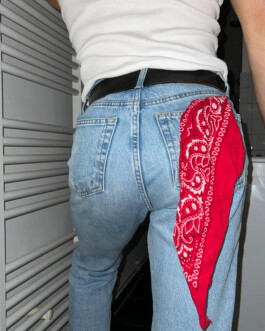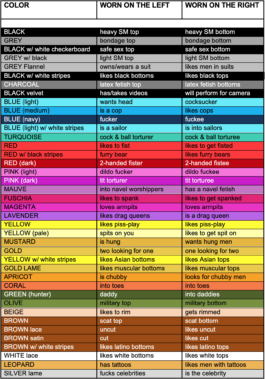
THE HANKY CODE
If you thought the bandana you wear around your neck is just a recent fashion trend, you are wrong.
by Clemens Egger (he/him), 09 April 2023
Although today it might be “en vogue” to wear colorful bandanas as your latest fashion accessories, it may confuse some of the older gay folks. And here is why.
The hanky code is the wearing of different colored bandanas in your back pants pocket or around your neck. It is also called the “bandana code”, some might even know it as “the handkerchief code” or “flagging”. The hanky code is a semiotic code that, depending on the color, indicates to potential sexual partners what your sexual preferences are. The position of the bandana additionally reveals what your sexual position in the bedroom is. It gained traction in the 1970s within the gay community, particularly within the leather and jeans community. There are a few theories on where the code originated from. Some say it all started in San Francisco after the gold rush from 1848 to 1854. With mostly male workers migrating to San Francisco to dig for gold, the disparity between men and women in the population increased. That consequently led to a shortage of women in square dance classes. So the men had to take the position of the female dance partner to achieve the right training. The men who danced the women’s part were marked with a red bandana around their neck. The other’s wore blue bandanas.
And there it was: The birthmark of the Hanky Code. But at that time, it had not much to do with the gay community. Another origin story of the hanky code dates back to the 1980s. A weekly New York magazine called “Village Voice” published a satirical story on the bandana phenomenon and how a colored piece of cloth replaced the already common keychain attached to your pants’ belt loop. The key chain has already been a popular sign for gay men to signal that they were gay and looking for uncommitted sex. Although its position already gave away your preferred sexual position, it didn’t say anything about your preferred sexual activities or fetishes. And that is why the leather and jeans community of the 1980s exchanged their keychains with colored bandanas, to make communication easier. Questions like ‘What are looking for?’ or ‘What are you into?’ became second nature once you saw a red bandana hanging out of someone’s left back pocket. But what does the color or position mean exactly?

adapted from The Saint Foundation
The hanky code is a semiotic code. Semiotics is the use of symbolic communication. That includes signs, logos, gestures and other linguistic and nonlinguistic communication methods. It says that all signs consist of a signifier and a signified. In the context of the hanky code, the color and the position of the bandana would therefore be the signifier. The signified is the idea the bandana elicits or, to put it in other words, the meaning we ascribe to its color and position. For example: If you are a bottom looking for someone with a big d*ck you would wear a mustard-colored bandana in your right pocket. If you are a top looking for someone whom you can fist, you might wear a red bandana in your left pocket. So red means fisting, a bright yellow means piss-play, and a hunter green indicates you are into dad-son-roleplay. These colors are quite specific just like dark pink, which signals you are into tit torturing. Or a charcoal grey that tells your opposite that you have a latex fetish. The color as the signifier indicates various sexual preferences, fantasies, or desires. But it is not only the shade or complexion of the color that is of great informative value. In some cases, the pattern or material plays a role as well. A checkerboard pattern for example indicates that you are only having safer sex. The position of your bandana is another signifier that tells your opposite what your sexual position is. Wearing the bandana on your right side, most commonly in your back pants pocket, means you are the person getting penetrated, also referred to as passive or bottom. The left side indicates you are the penetrator, also referred to as active or top. Whereby it is not completely clarified, there is the assumption that wearing the bandana around your neck means you are versatile; hence you are into both sexual positions.
Whereas today, you put all the information on your personal sexual preferences, fetishes, or fantasies in your Grindr profile description, during the time before online dating, the hanky code was a very helpful tool for people looking for uncommitted sex. No doubt that it was much more of a risk to talk openly about matters of sex as gay men, living in a repressive society. Today not only society is more accepting of queer people but also more sex-positive than it was in the 1980s and 1990s. That leads to the question of where the hanky code is today.
An ethnographic study conducted by researchers Andrew Reilly and Eirik J. Saethre in 2013 investigated the evolution of the hanky code. After talking to several gay men, they concluded that the hanky code is not extinct, but its meaning translates differently today. The hanky code is not used the same way as it has back in the day. It became a fashion statement. Whereas the older generation might still use the semiotic code for sexual advertising, younger gays wear it for the looks. But not only gay men wear the handkerchief as their new fashion piece. It is also worn by straight people. Whether the straights know that a red bandana indicates a preference for fisting or brown for defecation is unsure. But the study could show that straight men use the hanky code for communicating too. They use the code to signify their interest in ‘alternative’ sex practices like BDSM or toys. And that trend is increasing, research shows.
Although one could argue that straight men (or straight people in general) are appropriating gay culture when they are using the hanky code, there has never been a strict rule on who’s allowed to use it. So, if you identify as a promiscuous person of all gender or sexual identities you should consider getting yourself the handkerchief that fits best for you. And if you were wearing a red bandana because it’s fashionable you might now understand some of the looks you got when you entered a gay club.